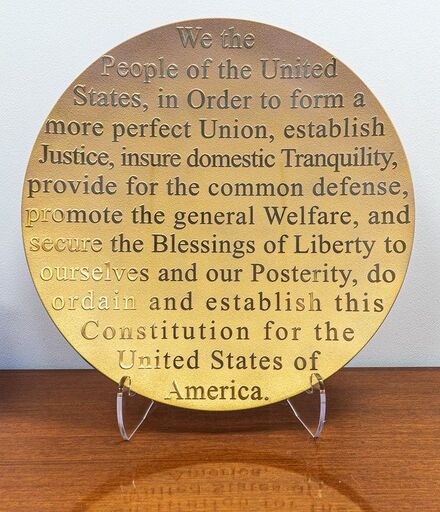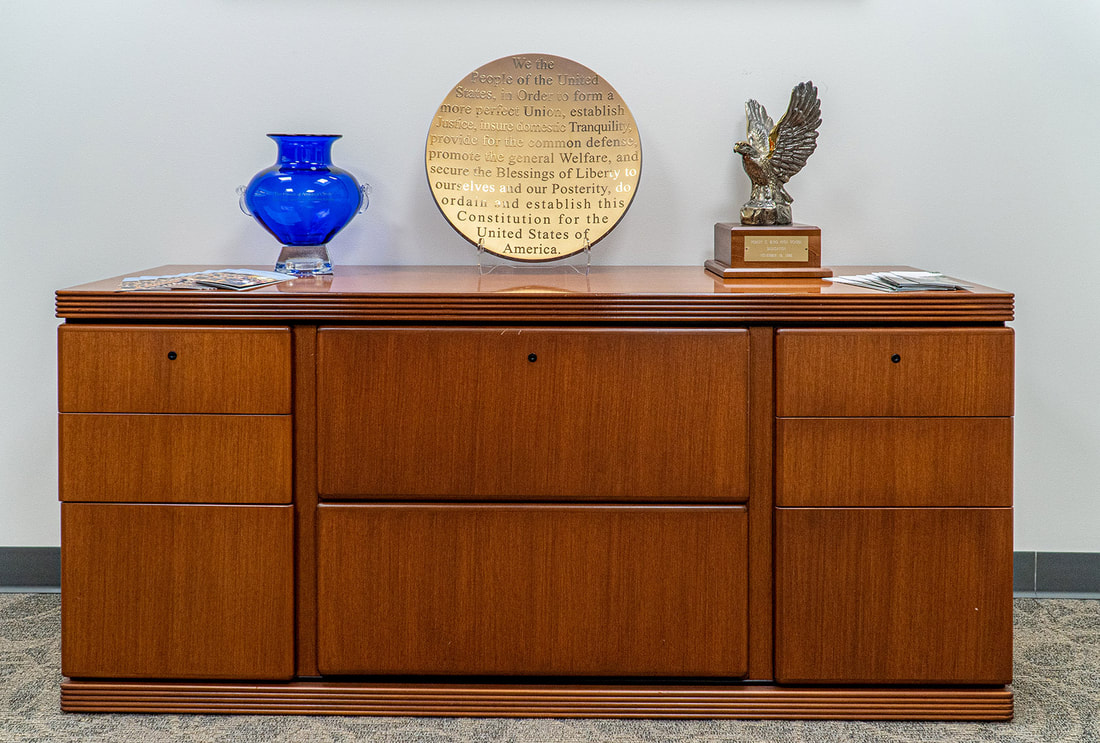|
By Ray Smock This is a story about the Preamble to the Constitution that I am telling now to give some context to a donation that my wife Phyllis and I have just made to the Byrd Center. We have long admired a fine piece of glass artwork displayed from time to time at the Shepherdstown, West Virginia shop Dickinson & Wait, which features beautiful art and crafts by American artists. This piece, a large circular plate with the entire Preamble to the Constitution in gold letters is by the California artist Stephen Schlanser, whose work is in the private collections of well-known public figures and world leaders. It was Phyllis who said to me this past weekend, “We have admired this piece for so long, it is time to get it and donate it to the Byrd Center.” I heartily concurred! I have long thought that the Preamble to the U.S. Constitution is the very best single sentence ever written that explains the purpose of government. It is fifty-two words in length. You could build an entire academic course around it, or use it to introduce young school kids about why we have government and what that means. And, you can even sing it! More about this later. The wording of the Preamble to the Constitution was not debated at the Federal Convention of 1787, and it does not have the legal authority that the text of the document does. It was pretty much a flourish, an introduction with little meaning when compared with the body of the document. There was nothing unusual about the idea of having a preamble. This was common practice in England and that practice came to the New World. An earlier famous preamble, the one to the Declaration of Independence in 1776, takes up most of the document. We do not learn until the final paragraph that it is a declaration of independence and the end of colonial allegiance to the British crown. That preamble contains the stirring words: “We hold these Truths to be self-evident, that all Men are created equal, that they are endowed by their Creator with certain unalienable Rights, that among these are Life, Liberty, and the Pursuit of Happiness….” After the debates of the Federal Convention neared conclusion in August 1787, Delegate Edmund Randolph of Virginia made the point that the Constitution was a legal document, not a philosophical one and therefore it was not necessary to have a preamble that dealt with the philosophy of the structure of the new government they were about to establish. So the early draft of the preamble began “We the People of the States of….” Then followed a list of each individual state. This draft ended with the phrase: “do ordain, declare and establish the following Constitution for the Government of Ourselves and our Posterity.” Without much thought, the delegates unanimously approved this draft. When the Constitution and its preamble went to a final Committee on Style just nine days before the delegates would approve the document, Gouverneur Morris of Pennsylvania, rewrote it and made it into literature and philosophy. He changed “We the People of the States of…” to “We the People of the United States….” There was no need to mention the states individually. Then Morris added six specific goals that described what the Constitution, and therefore, what Government itself was about: to form a more perfect Union, establish Justice, insure domestic Tranquility, provide for the common defence, promote the general Welfare, and secure the Blessings of Liberty. This remarkably revised Preamble and the body of the Constitution was approved on September 17, 1787. Edmund Randolph who was instrumental in defining the purpose of the Preamble was one of three delegates who refused to approve the Constitution that day. He was against it because it did not have a bill of rights and he thought it gave too much power to the executive branch. The Preamble is important as a philosophical concept of what government is for, and what it should achieve for the people of the nation. It is so easy to get lost in the specific issues and circumstances of any particular point in American history that we sometimes need to return to the Preamble as a touchstone and ask ourselves, how well we are doing in the six broad areas of purpose. Now, to return to my reference about singing the Preamble. On the 200th anniversary of Constitution in 1987, it was my job as the first official Historian of the House of Representatives and as director of the Office for the Bicentennial of the House to plan, in conjunction with my Senate colleagues, major commemorative events. One of the biggest was an excursion of a large contingent of House and Senate members via a special Amtrak train, to Philadelphia for the convening of special sessions of the House and Senate on the grounds of Independence Hall, where the Constitution was drafted and approved. Earlier during the bicentennial, my friend Franklin Roberts, a Philadelphia producer of historical events, had created a production with a troop of singers and actors (including one portraying Ben Franklin) who told the story of the drafting of the Constitution in song. It was called “Four Little Pages.” It was a popular presentation at National Parks and other venues during the bicentennial years. I was so taken with this show that I wanted the Representatives assembled in Philadelphia to allow the troop onto the floor to sing the Preamble as the finale of our session. And, I wanted the Members of Congress, and the Speaker of the House, Jim Wright of Texas, to sing along. Speaker Wright was reluctant when I first presented the plan to him. I took a video tape of the performance to his private office and he watched it with interest. But he wondered if the dignity of our ceremony, and the solemnity of the speeches that day would be undercut by a troop of singers. He told me to have the actors assembled outside the chamber, and, if, at the last minute, it seemed right to him, he would give me the nod and I could bring the troop in. At the very last moment the Speaker looked over to me and gave me the OK. I nodded to an assistant nearer the door, and the singers were ushered in. As the Speaker announced some “special guests” the troop came in and after formally bowing to the Speaker and the members, and they won the chamber over. Listening to the members of the House of 1987 singing the words of the Preamble drafted 200 years earlier, was one of my best moments as House Historian. I will think of that moment, and all that these 52 words mean to this nation every time I pass this lovely work of art. May it inspire those who see it to reflect on the meaning of government. Comments are closed.
|
Welcome to the Byrd Center Blog! We share content here including research from our archival collections, articles from our director, and information on upcoming events.
Categories
All
Archives
July 2023
|
Our Mission: |
The Byrd Center advances representative democracy by promoting a better understanding of the United States Congress and the Constitution through programs and research that engage citizens.
|
Copyright © Robert C. Byrd Center for Congressional History and Education
|



 RSS Feed
RSS Feed
